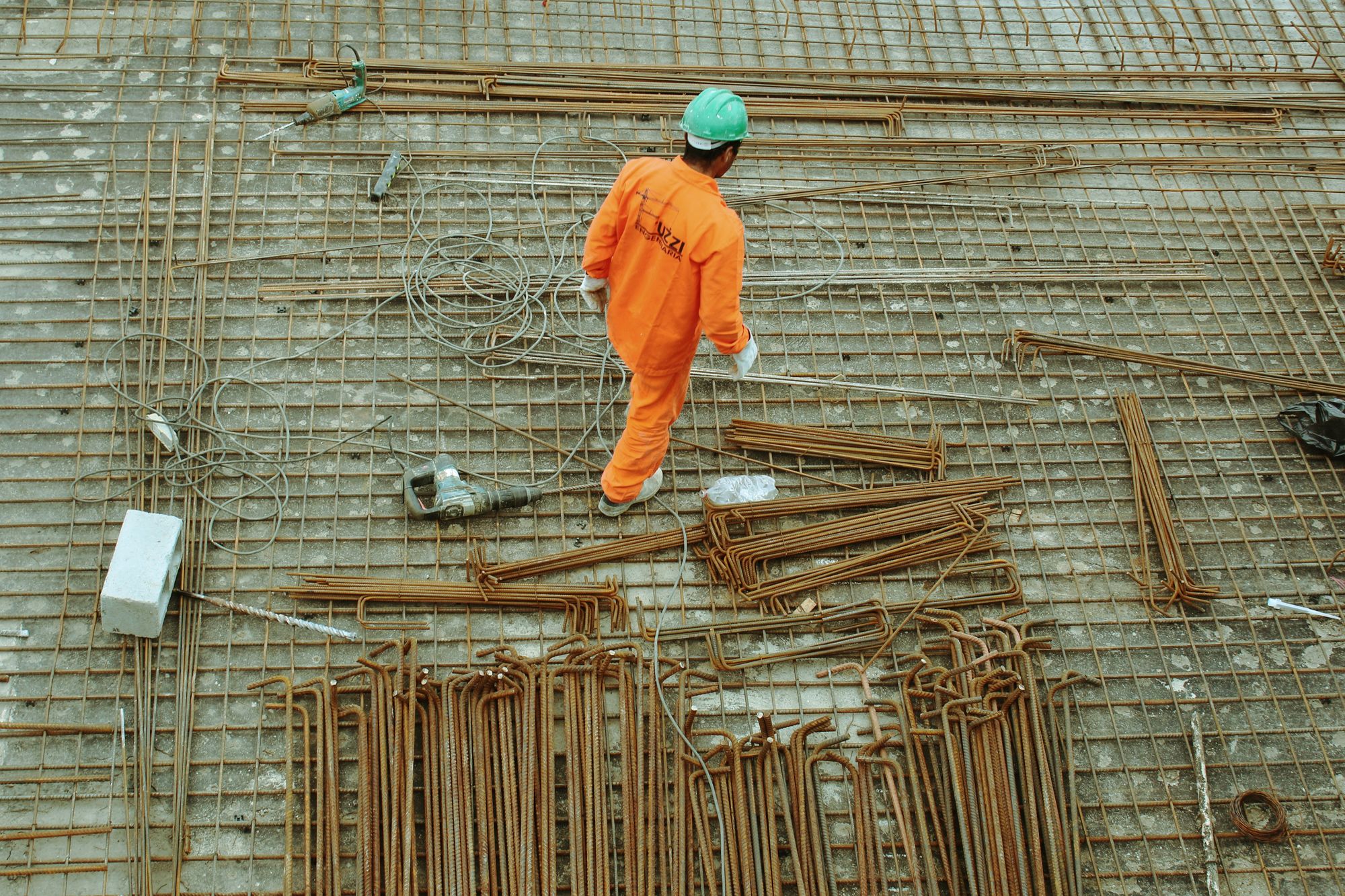Building Amidst Constraints: Overcoming Tight Credit for Construction Loans in Today's Market
While the current credit market is undeniably challenging, it is also an opportunity.

Table of Contents:
- Introduction: Current State of Construction Loans in a Tight Credit Market.
- The Challenge: Overcoming Credit Constraints for Builders.
- The Solution: Navigating Tight Credit Conditions in Construction.
- Strategic Approach: Builders' Financial Strategies in Tight Credit.
- Case Study: Overcoming Construction Financing Challenges.
- Conclusion: Encouraging and Supporting Builders Amidst Constraints.
- Q&A Section: Navigating Tight Credit Markets in Construction
Key Takeaways:
- The current financial landscape presents a tight credit market, creating significant challenges for the construction industry, particularly in securing loans.
- Tight credit conditions have a substantial impact on builders, with key hurdles including high-interest rates, stringent loan requirements, and a general reluctance from banks to fund construction projects.
- Despite these challenges, there are solutions available for navigating tight credit conditions. These include seeking alternative funding sources, leveraging government programs, and adapting business practices to meet credit requirements.
- Notable financial strategies that builders can employ in a tight credit market include fostering strong relationships with lenders, maintaining a robust credit profile, and exploring non-traditional funding options.
- Real-life case studies show that it's possible to successfully navigate the tight credit market. The strategies used in these cases can serve as a blueprint for other builders facing similar challenges.
- The article concludes on a hopeful note, underscoring that with the right approach and resources, builders can successfully secure financing and carry out their construction projects, even amidst tight credit constraints.
Introduction: Current State of Construction Loans in a Tight Credit Market
In the shadow of a tightening credit landscape, a recent report unveils a stark reality: a 30% plunge in construction loan approvals over the past year alone, signaling an era of unprecedented financial strain for the construction sector. This chilling statistic not only underscores the urgency of the situation but also sets the stage for a crucial discussion on resilience and adaptability in the face of such financial adversities.
Navigating the New Normal: Strategies for Thriving in a Tight Credit Market
As the construction industry grapples with this new normal, our focus shifts towards innovative solutions and strategic maneuvers designed to navigate these turbulent waters. This article aims to demystify the financial challenges at hand, offering a beacon of hope through a detailed exploration of alternative funding avenues, leveraging government programs, and the strategic fortification of lender relationships. From the tactical adjustments in business operations to the adoption of cutting-edge financial management practices, we unpack a comprehensive toolkit to not only survive but thrive amidst the tight credit constraints.
Join us as we chart a course through this challenging landscape, armed with practical strategies and real-life success stories, paving the way for a resilient and prosperous future for builders and contractors alike.
The Challenge: Overcoming Credit Constraints for Builders
The ongoing tight credit market poses a formidable challenge for builders. The constrained access to funding has a domino effect on various aspects of construction projects, impacting everything from project timelines to overall feasibility. This section delves into the specific impacts of tight credit conditions on builders and the key credit hurdles they face.
The Impact of Tight Credit Conditions on Builders
Tight credit conditions have a multifaceted impact on builders. The most immediate effect is on project financing. With banks and financial institutions becoming increasingly selective, builders often find themselves unable to secure the necessary funding. This can delay project timelines, increase costs, and in some cases, render projects unfeasible.
A survey conducted by the Associated General Contractors of America (AGC) found that 44% of builders reported project delays due to a lack of funding. In some extreme cases, tight credit conditions have led to a complete halt of projects. For instance, XYZ Construction had to postpone three of their major projects in 2021 due to insufficient financing.
Another crucial impact is on a builder’s capacity to bid for new projects. With limited access to credit, builders are often unable to provide the necessary assurances or upfront costs required to secure new projects. This significantly hampers their growth and expansion potential.

Key Credit Hurdles for Construction Projects
Several key hurdles contribute to the difficulty of securing construction loans in a tight credit market. The first is the stringent loan approval criteria. Banks have tightened their lending criteria, making it harder for many builders to qualify for loans. Builders now need to demonstrate a higher level of financial stability, creditworthiness, and project viability to secure loans.
Interest rates pose another significant hurdle. As mentioned earlier, the average interest rate for construction loans has risen by 1.5% over the past year. This increase not only makes the loans more expensive but also adds to the overall project costs, impacting the profitability of construction projects.
The third hurdle is the increased demand for collateral. In a bid to mitigate risks, lenders are now demanding more substantial collateral. This can be a significant challenge for builders, particularly small and medium-sized enterprises, who may not have the required assets.
Lastly, the length of the loan approval process also poses a challenge. With more stringent checks and balances in place, the loan approval process has become longer. This can significantly delay project timelines and increase holding costs.
Overcoming these challenges requires a new approach to securing construction financing, an understanding of the available solutions, and the strategic use of financial resources. The next sections of this article will delve into these aspects in more detail.
The Solution: Navigating Tight Credit Conditions in Construction
While the tight credit market poses significant challenges, it is not an insurmountable hurdle. Innovative strategies and a proactive approach can help navigate these challenging conditions. This section explores the solutions that builders can employ to secure funding and adapt to the credit constraints within the construction industry.
Securing Funding During Challenging Credit Times: A Step-by-Step Guide
In a market where credit is as tight as a drum, finding funding can feel like navigating a labyrinth in the dark. Here's a beacon of light: a step-by-step guide designed to help you secure the financing you need to keep your projects moving forward.
Step 1: Broaden Your Funding Horizons
• Explore Beyond Traditional Banks: Start by researching credit unions, private lenders, and online financial platforms. Each has unique lending criteria and may be more flexible than traditional banks.
• Action: Make a list of at least five non-traditional lending sources to contact.
Step 2: Tap into Government Programs and Grants
• Identify Relevant Programs: Look for low-interest loan programs, grants, and financial incentives offered by the government that align with your projects, especially those focusing on infrastructure or affordable housing.
• Action: Visit the official websites of the U.S. Department of Housing and Urban Development (HUD) and other relevant agencies to find programs for which you qualify.
Step 3: Strengthen Relationships with Lenders
• Build a Lender Network: Don’t put all your eggs in one basket. Develop relationships with multiple lenders to increase your chances of securing a loan.
• Action: Schedule meetings or calls with potential lenders to present your projects and discuss financing options.
Step 4: Optimize Your Financial Health
• Improve Your Credit Score and Financial Records: Ensure your financial documents are in order, and work on improving your credit score. A strong financial profile is attractive to lenders.
• Action: Review your credit report for errors, pay down existing debt, and prepare clear financial statements.

Adapting to Credit Constraints in the Construction Industry
Adapting to credit constraints requires builders to reassess their business strategies. They must scrutinize every aspect of their operations, from project selection to cost management, to ensure maximum efficiency and profitability.
In terms of project selection, builders should focus on projects with a high potential for return on investment. This not only improves the business's profitability but also makes it more attractive to lenders. It may also be beneficial to focus on projects that align with government priorities, such as infrastructure or affordable housing, as these are more likely to qualify for government funding.
Cost management is another crucial aspect. Builders should strive to reduce costs without compromising on quality. This can be achieved through various strategies, such as bulk purchasing, negotiating with suppliers, optimizing operational processes, and using technology to increase efficiency.
Another important adaptation is to anticipate and manage risks proactively. This includes financial risks, project risks, and market risks. Effective risk management can help prevent cost overruns, project delays, and other issues that could negatively impact a builder's credit profile or financial stability.
Lastly, builders should invest in technology and innovation. This can help increase efficiency, reduce costs, and improve project outcomes, making the business more attractive to lenders. This can include investing in construction management software, adopting green building practices, or exploring innovative construction methods.
Navigating the tight credit market requires a combination of these strategies, coupled with a deep understanding of the current financial landscape. While challenging, these conditions also present an opportunity for builders to innovate, improve efficiency, and strengthen their financial management practices.
Strategic Approach: Builders' Financial Strategies in Tight Credit
In a tight credit market, builders must adopt strategic financial approaches to navigate the challenges and ensure project viability. Here are several strategies, illustrated with real-life examples, that have proven effective.
Firstly, maintaining a strong balance sheet is paramount. Builders should focus on improving their liquidity, reducing unnecessary expenses, and ensuring efficient management of assets and liabilities. For example, the DEF Construction Company implemented rigorous financial controls and cost-cutting measures, improving their net income by 15%. This enhanced financial performance made them more attractive to lenders, helping them secure necessary funding despite the tight credit market.
Secondly, builders can consider equity financing, wherein they sell part of their stake in a project or company to investors. This approach can be particularly effective for large-scale projects or companies with a strong growth trajectory. For instance, GHI Builders successfully raised 30% of their project costs by selling a stake in their high-profile commercial project to a private equity firm.
Joint ventures represent another strategic approach. By partnering with other builders or investors, companies can pool resources and share risks. JKL Construction, for instance, entered into a joint venture with another builder to undertake a major residential project. This reduced their individual financial commitment and made it easier to secure the necessary funding.
Additionally, pre-sales or forward sales can be a useful strategy, particularly for residential projects. By selling properties before construction completion, builders can secure a portion of the project's funding upfront. MNO Developers used this strategy effectively for their latest residential project, securing 40% of project costs through pre-sales.
Leveraging government programs and incentives is another strategic move. Various programs provide financial support for construction projects, particularly those focused on infrastructure or affordable housing. For instance, PQR Builders secured a low-interest loan from a state program aimed at promoting affordable housing, enabling them to proceed with a large-scale housing project.
Finally, builders can consider project finance, a loan structure where the loan is repaid from the project's cash flows. This strategy can be effective for builders with strong project portfolios and solid track records. For example, STU Construction secured project financing for their latest commercial project based on the projected rental income from the property.
These strategies, however, are not mutually exclusive and can be used in combination to navigate the tight credit market. The key is to understand the financial landscape, assess the feasibility of each strategy, and choose the ones that align best with the company’s financial situation and project requirements. Despite the challenging conditions, with the right strategies and a proactive approach, builders can successfully navigate the tight credit market and ensure the viability of their projects.

Case Study: Overcoming Construction Financing Challenges
A shining example of navigating through the tight credit market is the story of JKL Construction. They were entrusted with a large-scale, mixed-use development project in the heart of a bustling city. However, securing the necessary funding proved challenging due to the tightened credit conditions.
JKL Construction adopted a multi-pronged strategy to overcome this hurdle. Firstly, they diversified their financing sources. Instead of relying solely on traditional bank loans, they sought funds from credit unions and private investors. This not only provided the required capital but also spread the financial risk across multiple parties.
Simultaneously, they also tapped into a state-funded program designed to spur local development. Their project, which included affordable housing units and public spaces, aligned perfectly with the program's goals, and they were able to secure a low-interest loan.
In addition, JKL Construction optimized their operations to reduce costs without compromising on quality. They leveraged technology to streamline processes, negotiated better terms with suppliers, and implemented stricter financial controls.
The result was a resounding success. Not only was JKL Construction able to complete the project on time and within budget, but the project also turned out to be one of their most profitable ventures, setting a benchmark for overcoming financial challenges in the construction industry.
Conclusion
The current credit market undeniably poses significant challenges for builders. However, as we have explored, these challenges are far from insurmountable. By employing innovative strategies and adopting a proactive approach, builders can not only survive but thrive in this environment.
Securing funding in such a market calls for diversification of sources, leveraging government programs, and building strong relationships with lenders. Adapting to credit constraints requires a thorough reassessment of business strategies, efficient cost management, proactive risk management, and investment in technology and innovation. Financial strategies such as maintaining a robust balance sheet, equity financing, joint ventures, pre-sales, and project finance can also be invaluable tools in navigating the tight credit market.
The case of JKL Construction exemplifies the power of these strategies. Despite facing significant financing challenges, they successfully completed a large-scale project, setting a shining example for the industry.
In conclusion, while the current credit market is undeniably challenging, it is also an opportunity. An opportunity for builders to reassess their strategies, refine their financial management practices, and explore innovative solutions. With the right approach and determination, builders can successfully navigate these challenges, ensuring the viability of their projects and the continued growth of the construction industry. Amidst constraints, the potential for successful construction financing remains strong, reflecting the resilience and adaptability of the industry.
Q&A Section: Navigating Tight Credit Markets in Construction
Q1: What are the first steps I should take when I realize traditional bank financing is not an option for my construction project?
A1: Start by reassessing your project's financial plan and explore alternative financing options. This includes looking into private lenders, credit unions, and crowdfunding platforms. Additionally, investigate government programs and grants that might be applicable to your project. It's also a good time to review and optimize your financial health to make your business more attractive to these alternative funding sources.
Q2: How can I improve my chances of securing a loan in a tight credit market?
A2: Enhance your loan application by ensuring your business plan is thorough and demonstrates a clear path to profitability. Maintain a strong credit score, provide detailed financial projections, and offer collateral if possible. Building a relationship with potential lenders and showcasing your past project successes can also significantly improve your chances.
Q3: Are there specific government programs designed to help construction projects during tough financial times?
A3: Yes, various federal and state programs offer support to construction projects, especially those focusing on infrastructure, renewable energy, and affordable housing. Programs through the U.S. Department of Housing and Urban Development (HUD) and the Small Business Administration (SBA) are good places to start. Each program has specific eligibility criteria, so it’s important to research which one aligns best with your project.
Q4: Can leveraging technology help my construction company navigate tight credit conditions?
A4: Absolutely. Adopting construction management software and financial management tools can streamline operations, reduce costs, and improve project efficiency. Demonstrating to lenders that your projects are managed efficiently with minimized risks can make your loan application more appealing.
Q5: What should I do if my loan application is rejected?
A5: First, ask for feedback on why the application was rejected to understand any potential weaknesses in your proposal. Use this feedback to improve your application, whether it’s strengthening your financial projections, enhancing your credit score, or seeking additional collateral. Consider applying to other lenders, as different institutions have varying criteria and risk appetites.
Q6: How important are personal and business credit scores in securing construction financing?
A6: They are very important. Lenders use these scores to gauge your creditworthiness and risk level. A high credit score can lead to more favorable loan terms, including lower interest rates. It’s crucial to maintain good credit by paying bills on time, reducing debt, and regularly checking your credit report for inaccuracies.
Q7: What are some non-traditional funding options I can explore for my construction project?
A7: Beyond traditional bank loans, consider private investors, peer-to-peer lending, crowdfunding, and construction factoring. Each option comes with its own set of advantages and considerations, such as equity requirements, interest rates, and funding speed. Researching and understanding these alternatives can provide viable pathways to secure the necessary project financing.
